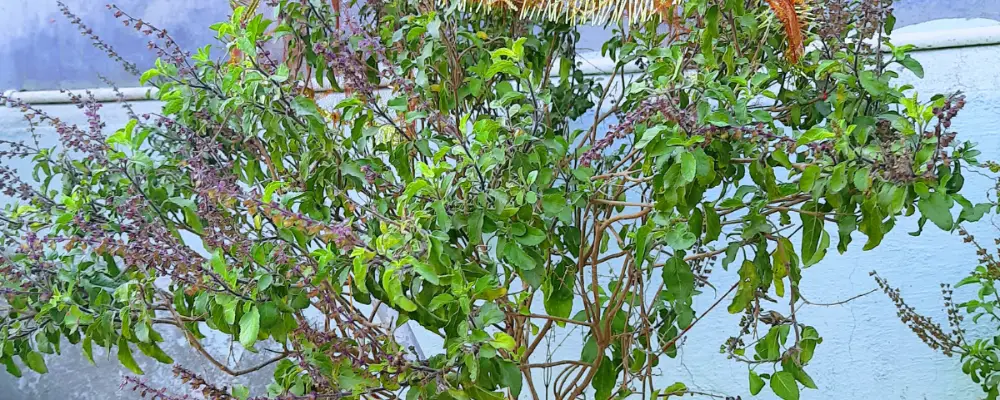The tulsi plant is commonly found in every Hindu home. It is recognized as basil that acts as a remedy for seasonal ailments such as flu, cold, and cough. As per Vastu, having a tulsi plant in a home brings harmony and happiness within the family.
However, one of the common questions that arises from people is where they should keep the tulsi plant at home. According to Vastu, it should be placed in the right direction for acquiring its complete benefits. Read on to learn about its right placement in a home.
Importance and Benefits of Tulsi Plant in Homes
Having a Tulsi plant at home has several benefits, such as:
- Promotes Immunity Level: The tulsi plant contains a rich amount of micronutrients and antioxidants, which helps you to fight against common ailments such as fever, asthma, cold, flu, etc. Drinking tulsi water or chewing tulsi leaves relieves you from a cold and sore throat.
- Purifies the Blood: This auspicious plant is primarily known to purify the blood and do wonders for your overall health and skin. It flushes out the toxins and cleans your entire digestive system.
- Regulates Blood Sugar Level: Consuming this ancient herb maintains Type-2 diabetes levels and reduces its damaging effects. Tulsi leaves improve the metabolism process and help the body process fats and carbohydrates.
- Reduces Blood Pressure: Hypertension brings a variety of troubles in your body, such as headaches, lack of sleep, high blood pressure, anxiety, and depression. Holy basil leaves are a powerful medicine that benefits a person by lowering high cholesterol levels and blood pressure.
- Promotes Peaceful Environment: Beyond all medicinal properties, tulsi is an auspicious plant that provides positive vibration around the home. It brings mental peace by eliminating stress.
- Purifies the Surroundings: The tulsi plant naturally contains a pleasant aroma that keeps the surroundings fresh. There is a belief that basil absorbs toxic gases from the air, such as carbon monoxide, sulphur dioxide, carbon dioxide, etc. Additionally, the plant has mosquito-repellent qualities.
- Therapeutic Properties: Tulsi is recognized for its anti-bacterial, anti-viral, and anti-fungal properties. These properties help fight against infections and health troubles like respiratory illnesses, cancer, skin problems, heart-related diseases, bacterial infections, etc.
Where to Keep Tulsi Plant at Home According to Vastu Shastra
It is believed that worshipping the tulsi plant results in long life and prosperity. But it is essential to make sure that the plant is placed in the right direction as per the rules of Vastu Shastra. If you are planning to keep a tulsi in your home, then follow these tips and suggestions:
- Locate a tulsi plant on the eastern side of your house, where it can obtain the first rays of sunlight in the morning. If it is not possible, you can keep it near the window or balcony in the north or north-east directions of your home.
- Avoid placing it in the southeast direction, which is the known direction of Agni or the fire god, as this can have negative influences.
- The location of your tulsi plant should be higher than the foundation of your home. In order to enjoy all the health and medicinal benefits, you should keep the plant neat and clean. The areas around the tulsi plant should not be covered with any unusual things such as mops, brooms, or clutter.
- Most importantly, this Vastu plant should not be grown with any thorny plant species like cactus, as it may lose its properties.
Placing the tulsi plant as per Vastu Shastra is the easiest way to enjoy all the medicinal properties and peaceful vibrations of the tulsi plant.
Number of Tulsi Plants to Keep as Per Vastu
According to the Vastu Shastra principles, a home should contain a tulsi plant in odd numbers such as one, three, five, etc. Following this rule promotes a peaceful environment and positive vibrations. As mentioned earlier, avoid placing a tulsi plant near any thorny plant for best results.
Best Day to Worship Tulsi Plant
Worshipping the tulsi plant on days such as Tuesday and Friday brings you peace and positive vibration in your home. These are the auspicious days of the week to do Pooja for the tulsi plant.
Do’s and Don’ts of Tulsi Plant as Per Vastu
Vastu Shastra offers specific guidelines and rules for the care and placement of tulsi plants. These are explained in detail below:
Do’s:
- As mentioned earlier, tulsi plants in the home should be placed in the north or northeast direction for the best results. These placements create positivity and growth in your life.
- Ensure the plant receives sufficient sunlight and water regularly, but avoid overwatering.
- The tulsi plant and its surroundings should be clean and free from clutter.
- Place flowering plants near tulsi, which improves positive energy.
Don’t’s
- Tulsi plants in the home shouldn’t be in even numbers like two, four, or six.
- Don’t allow the plant to over dry or get withered, watering often is essential to keep it fresh.
- Avoid placing thorny plants and other unusual things like shoes, dustbins, brooms, etc.
Final Thoughts
The tulsi plant is an indispensable part of ancient tradition and is commonly found in many Hindus homes. Beyond worshipping, this auspicious plant provides numerous health benefits and strength to fight against evil and sinful energies. Follow the rules mentioned in this blog to avail its complete benefits.

